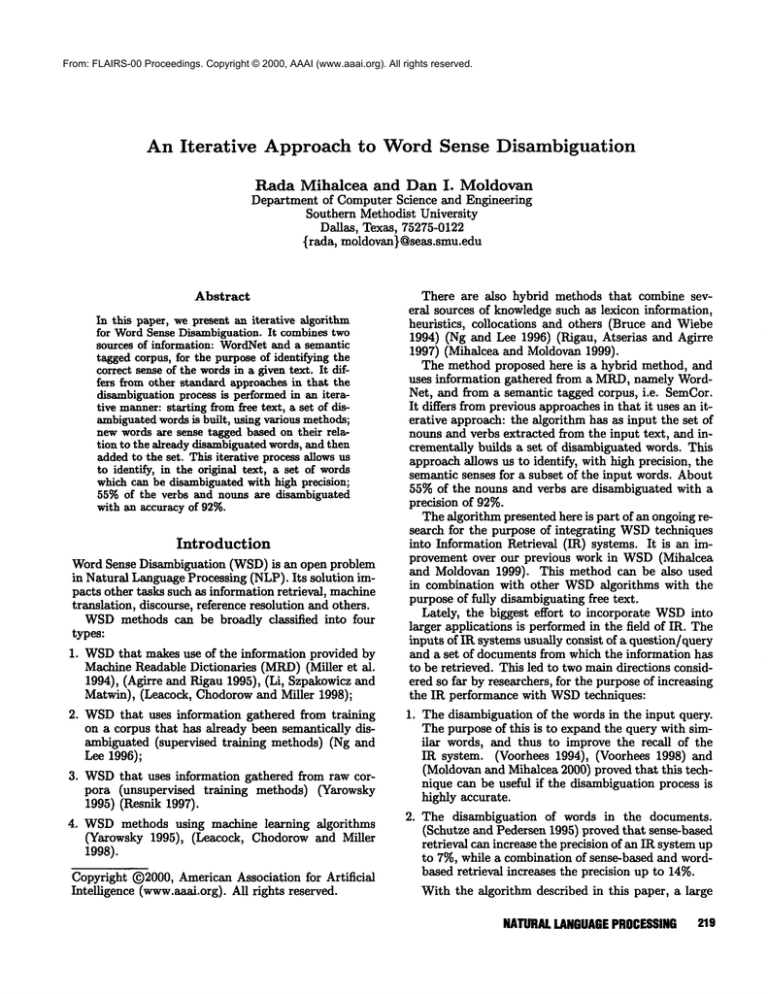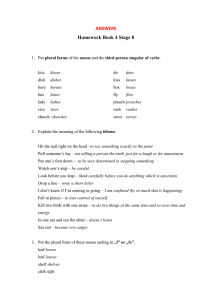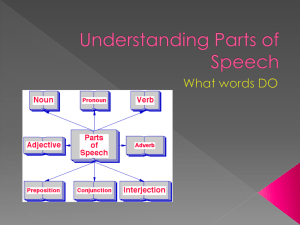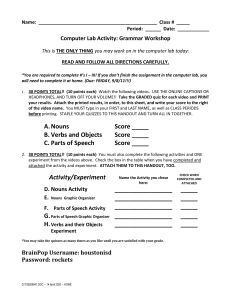
From: FLAIRS-00 Proceedings. Copyright © 2000, AAAI (www.aaai.org). All rights reserved.
An Iterative
Approach to Word Sense Disambiguation
Rada Mihalcea
and Dan I. Moldovan
Department of Computer Science and Engineering
Southern Methodist University
Dallas, Texas, 75275-0122
{rada, moldovan} @seas.smu.edu
Abstract
In this paper, we present an iterative algorithm
for WordSense Disambiguation. It combines two
sources of information: Word_Netand a semantic
tagged corpus, for the purpose of identifying the
correct sense of the wordsin a given text. It differs from other standard approaches in that the
disambiguation process is performed in an iterative manner:starting from free text, a set of disambiguatedwordsis built, using various methods;
new words are sense tagged based on their relation to the already disambiguatedwords, and then
addedto the set. This iterative process allows us
to identify, in the original text, a set of words
which can be disambiguated with high precision;
55%of the verbs and nouns are disambiguated
with an accuracy of 92%.
Introduction
Word Sense Disambiguation (WSD)is an open problem
in Natural Language Processing (NLP). Its solution impacts other tasks such as information retrieval, machine
translation, discourse, reference resolution and others.
WSDmethods can be broadly classified
into four
types:
1. WSDthat makes use of the information provided by
Machine Readable Dictionaries (MRD)(Miller et
1994), (Agirre and Rigau 1995), (Li, Szpakowicz
Matwin), (Leacock, Chodorow and Miller 1998);
2. WSDthat uses information gathered from training
on a corpus that has already been semantically disambiguated (supervised training methods) (Ng
Lee 1996);
3. WSDthat uses information gathered from raw corpora (unsupervised training methods) (Yarowsky
1995) (Resnik 1997).
4. WSDmethods using machine learning algorithms
(Yarowsky 1995), (Leacock, Chodorow and Miller
1998).
Copyright ©2000, American Association for Artificial
Intelligence (www.aaal.org). All rights reserved.
There are also hybrid methods that combine several sources of knowledgesuch as lexicon information,
heuristics, collocations and others (Bruce and Wiebe
1994) (Ng and Lee 1996) (Rigau, Atserias and Agirre
1997) (Mihalcea and Moldovan 1999).
The method proposed here is a hybrid method, and
uses information gathered from a MRD,namely WordNet, and from a semantic tagged corpus, i.e. SemCor.
It differs from previous approachesin that it uses an iterative approach: the algorithm has as input the set of
nouns and verbs extracted from the input text, and incrementally builds a set of disambiguated words. This
approach allows us to identify, with high precision, the
semantic senses for a subset of the input words. About
55% of the nouns and verbs are disambiguated with a
precision of 92%.
The algorithm presented here is part of an ongoing research for the purpose of integrating WSDtechniques
into Information Retrieval (IR) systems. It is an improvement over our previous work in WSD(Mihalcea
and Moldovan 1999). This method can be also used
in combination with other WSDalgorithms with the
purpose of fully disambiguating free text.
Lately, the biggest effort to incorporate WSDinto
larger applications is performed in the field of IR. The
inputs of IR systems usually consist of a question/query
and a set of documents from which the information has
to be retrieved. This led to two main directions considered so far by researchers, for the purpose of increasing
the IR performance with WSDtechniques:
1. The disambiguation of the words in the input query.
The purpose of this is to expand the query with similar words, and thus to improve the recall of the
IR system. (Voorhees 1994), (Voorhees 1998)
(Moldovan and Mihalcea 2000) proved that this technique can be useful if the disambiguation process is
highly accurate.
2. The disambiguation
of words in the documents.
(Schutze and Pedersen 1995) proved that sense-based
retrieval can increase the precision of an IR system up
to 7%, while a combination of sense-based and wordbased retrieval increases the precision up to 14%.
With the algorithm described in this paper, a large
NATURAL
LANGUAGE
PROCESSING 219
subset of the words in the documents can be disambiguated with high precision, allowing for an efficient
combined sense-based and word-based retrieval.
Resources
WordNet(WordNet 1.6 has been used in our method)
a Machine Readable Dictionary developed at Princeton
University by a group led by George Miller (Fellbaum
1998). WordNet covers the vast majority of nouns,
verbs, adjectives and adverbs from the English language. It has a large network of 129,504 words, organized in 98,548 synonymsets, called synsets.
The main semantic relation defined in WordNetis the
"is a" relation; each concept subsumes more specific
concepts, called hyponyms, and it is subsumed by more
general concepts, called hypernyms. For example, the
concept {machine} has the hypernym {device}, and
one of its hyponyms is {calculator,
calculating
machine}.
WordNet defines one or more senses for each word.
Dependingon the number of senses it has, a word can be
(1) monosemous,i.e. it has only one sense, for example
the noun interestingness,
or (2) polysemous, i.e. it
has two or more senses, for example the noun interest
which has seven senses defined in WordNet.
SemCor. SemCor(Miller et al. 1993) is a corpus formed
with about 25%of the Browncorpus files; all the words
in SemCorare part-of-speech tagged and semantically
disambiguated. In the algorithm described here, we use
the brownl and brown2 sections of SemCor, containing
185 files; from these, 6 files are used with the purpose
of testing our method; the other 179 files form a corpus
used to extract rules with procedure 3 and to determine
noun-contexts for procedure 4 (as described in the next
section).
Iterative
Word Sense Disambiguation
The algorithm presented in this paper determines, in a
given text, a set of nouns and verbs which can be disambiguated with high precision. The semantic tagging
is performed using the senses defined in WordNet.
In this section, we are going to present the various
methods used to identify the correct sense of a word.
Next, we present the main algorithm in which these
procedures are invoked in an iterative manner.
PROCEDURE1. This procedure uses a Named Entity (NE) component to recognize and identify person
names, locations, company names and others. The various names are recognized and tagged. Of interest for
our purpose are the PER (person), ORG(group)
LOC(location) tags. The words or word collocations
marked with such tags are replaced by their role (person, group, location) and marked as having sense #1.
Example. ’ ’Scott Hudson’ ’ is identified as a person
name, thus this word group will be replaced with its
role, i.e. person, and marked with sense #1.
PROCEDURE
2. Identify the words having only one
sense in WordNet (monosemous words). Mark them
with sense #1.
22O
FLAIRS-2000
Example. The noun subcommittee has one sense defined in WordNet. Thus, it is a monosemousword and
can be marked as having sense #1.
PROCEDURE
3. With this procedure, we are trying to
get contextual clues regarding the usage of the sense
of a word. For a given word Wi, at position i in the
text, form two pairs, one with the word before Wi (pair
Wi-t-Wi) and the other one with the word after Wi
(pair Wi-Wi+l). Determiners or conjunctions cannot be
part of these pairs. Then, we extract all the occurrences
of these pairs found within the semantic tagged corpus
formed with the 179 texts from SemCor. If, in all the
occurrences, the word Wi has only one sense #k, and
the number of occurrences of this sense is larger than
a given threshold, then mark the word Wi as having
sense #k.
Example. Consider the word approval in the text fragment "committee approval of", and the threshold set to 3. The pairs formed are "committee
approval’ ’ and ’ ’ approval of’ ’. No occurrences of
the first pair are found in the corpus. Instead, there are
four occurrences of the second pair:
"... with the appro~al#lof the FarmCredit Association..."
"... subject to the approral#Iof the Secretary of State ..."
"... administrativeapproval#1of the reclassification ... "
"... recommended
approval#1of the 1-A classification ..."
In all these occurrences the sense of approval is sense
#1. Thus, approval is marked with sense #1.
PROCEDURE
4. For a given noun N in the text, determine the noun-context of each of its senses. This
noun-context is actually a list of nouns which can occur
within the context of a given sense i of the noun N.
In order to form the noun-context for every sense Ni,
we determine all the concepts in the hypernym synsets
of Ni. Also, using SemCor, we determine all the nouns
which occur within a windowof 10 words respect to Ni.
All of these nouns, determined using WordNet and
SemCor, constitute
the noun-context of Ni. We can
now calculate the number of commonwords between
this noun-context and the original text in which the
noun N is found.
Applying this procedure to all the senses of noun N
will provide us with an ordering over its possible senses.
Wepick up the sense i for the noun N which: (1) is
the top of this ordering and (2) has the distance to the
next sense in this ordering larger than a given threshold.
Example. The word diameter, as it appears in a
text from the aerodynamics field (Cranfield collection), has two senses. The commonwords found between the noun-contexts of its senses and the text
are: for diameter#i: ( property, hole, ratio } and for
diameter#2: { form}. For this text, the threshold was
set to 1, and thus we pick diameter#1 as the correct
sense (there is a difference larger than 1 between the
number of nouns in the two sets).
PROCEDURE
5. Find words which are semantically connected to the already disambiguated words for which
the connection distance is 0. The semantic distance is
computed based on the WordNet hierarchy; two words
are semantically connected at a distance of 0 if they
belong to the same synset.
Example. Consider these two words appearing in the
text to be disambiguated: authorize and clear. The
verb authorize is a monosemousword, and thus it is
disambiguated with procedure 2. One of the senses of
the verb clear, namely sense #4, appears in the same
synsetwithauthorize#l,
and thusclearis markedas
havingsense#4.
PROCEDURE
6. Findwordswhichare semantically
connected,and for whichthe connection
distance
is 0.
This procedure
is weakerthanprocedure5: noneof
thewordsconsidered
by thisprocedure
arealready
disambiguated.
We haveto consider
allthesensesof both
wordsin orderto determine
whetheror not the distancebetween
themis 0, andthismakesthisprocedure
computationally
intensive.
Example. For the words measure and bill, both of
them ambiguous, this procedure tries to find two possible senses for these words, which are at a distance of 0,
i.e. they belong to the same synset. The senses found
are measure#4 and bill#l, and thus the two words are
marked with their corresponding senses.
PROCEDURE
7. Find words which are semantically connected to the already disambiguated words, and for
which the connection distance is maximum1. Again,
the distance is computed based on the WordNethierarchy; two words are semantically connected at a maximumdistance of 1 if they are synonyms or they belong
to a hypernymy/hyponymy relation.
Example. Consider the nouns subcommittee and
committee. The first one is disambiguated with procedure 2, and thus it is marked with sense #1. The
word committee with its sense #1 is semantically linked
with the word subcommittee by a hypernymy relation.
Hence, we semantically tag this word with sense #1.
PROCEDURE
8. Find words which are semantically connected among them, and for which the connection distance is maximum1. This procedure is similar with
procedure 6: both words are ambiguous, and thus all
their senses have to be considered in the process of finding the distance between them.
Example. The words gift and donation are both ambiguous. This procedure finds gift with sense #1 as
being the hypernym of donation, also with sense #1.
Therefore, both words are disambiguated and marked
with their assigned senses.
The procedures presented above are applied iteratively; this allows us to identify a set of nouns and
verbs which can be disambiguated with high precision.
About 55% of the nouns and verbs are disambiguated
with 92% accuracy.
Algorithm
Step 1. Pre-process the text. This implies tokenization and part-of-speech tagging. The part-of-speech
tagging task is performed with high accuracy using
an improved version of Brill’s tagger (Brill 1992).
this step, we also identify the complex nominals, based
on WordNetdefinitions.
For example,the wordsequence’ ’pipeline
companies’
’ is foundin WordNet
andthusit is identified
as a singleconcept.
Thereis
alsoa listof wordswhichwe do notattempt
to disambiguate.
Thesewordsaremarkedwitha special
flagto
indicate
thattheyshould
notbe considered
in thedisambiguation
process.
So far,thislistconsists
ofthree
verbs: be, have, do.
Step 2. Initialize
the Set of Disambiguated Words
(SDW)with the empty set SDW={}.Initialize
the Set
of Ambiguous Words (SAW)with the set formed by all
the nouns and verbs in the input text.
Step 3. Apply procedure 1. The named entities identified here are removed from SAWand added to SDW.
Step ~. Apply procedure 2. The monosemous words
found here are removed from SAWand added to SDW.
Step 5. Apply procedure 3. This step allows us to
disambiguate words based on their occurrence in the
semantically tagged corpus. The words whose sense is
identified with this procedure are removed from SAW
and added to SDW.
Step 6. Apply procedure 4. This will identify a set
of nouns which can be disambiguated based on their
noun-contexts.
Step 7. Apply procedure 5. This procedure tries to
identify a synonymy relation between the words from
SAWand SDW.The words disambiguated are removed
from SAW and added to SDW.
Step8. Applyprocedure
6. Thisstepis different
from
the previous
one,as the synonymy
relation
is sought
amongwords in SAW (no SDW wordsinvolved).The
wordsdisambiguated
are removedfromSAW and added
to SDW.
Step9. Applyprocedure
7. Thissteptriesto identify
wordsfromSAWwhicharelinkedat a distance
of maximum 1 with the wordsfrom SDW. Removethe words
disambiguated
from SAW and add them to SDW.
Step 10. Applyprocedure8. This procedurefinds
wordsfromSAW connectedat a distanceof maximum
1. As in step8, no wordsfromSDWareinvolved.
The
wordsdisambiguated
are removedfromSAW and added
to SDW.
An Example
Weillustrate
here the disambiguation algorithm with
the help of an example; for this, we consider the following set of sentences extracted from the file br-m02 from
SemCor.
"...
Instead
of inflecting
cle to indicate
a verb or using an unattached
the past or future,
ent word.
Thus,
galu’ahai,
meaning to live,
the masculine
Siddo used an entirely
animate
infinitive
was, in the perfect
tense,
partidiffer-
dabhumaksaniksu’u’peli’afo,
and, in the future, mai’teipa. The same use of an entirely different
toord applied for all the other tenses. Plus the fact that Siddo not
only had the
feminine,
tual.
it
normal (to
and neuter,
Earthmen)
three
but the two e:~tra
Fortunately,
gender was inflected,
would be difficult
for anybody
genders
of masculine,
of inanimate
and spiri-
though the ezpression
not born in Siddo.
of
The system
NATURAL
LANGUAGE
PROCESSING 221
Set
1
2
3
4
5
6
AVERAGe.I
No. I Proc.l+2
Proc.3
I Proc.4
] Proc.5+6 I Proc.7+8
]
words
No. Acc.
No. Acc.
No. Acc.
No. Acc.
No. Acc.
151
35
100% 35
100%
59
94%
73
87.8% 88 82.5%
128
47
100% 5O 98.4% 65
93.6% 7O
90.4% 85
85.7%
108
36
100% 40
100% 48
98.2% 53
98.3% 62
91.2%
159
4O lOO% 43
100% 62
89.6% 64
88.6%
72
88.5%
87.9%
159
52
100% 55
100% 76
91.9% 82
91.3% 89
89
33
100% 35
100% 41
100% 41
100% 43
100%
132 I 40 I lOO%l43 199.7%158.5194.6%163.8192.7%173.2189.3%[
Table 1: Results obtained for sets of sentences from file br-a01
File
br-a01
br-a02
br-k01
br-kl8
br-m02
br-r05
No. Proc.l+2
words No. Acc.
132
4O
100%
135
49
100%
68.1
17.2 100%
60.4
18.1 100%
63
17.3 100%
72.5
14.3 100%
AVERAGE
I 88.5 I 25.9 I 100%I
Proc.3
I Proc.4
l Proc.5+6
l Vroc.7+8
]
No. Acc.
No. Acc.
No. Acc.
[ No. Acc.
43
99.7% 58.5 94.6% 63.8 92.7% 73.2 89.3%
52.5 98.5% 68.6
94%
75.2 92.4% 81.2 91.4%
23.3 99.7% 38.1 97.4% 40.3 97.4% 41.8 96.4%
20.7 99.1% 26.6 96.9% 27.8 95.3% 29.8 93.2%
20.3 98.1% 26.1
95% 26.8 94.9% 30.1 93.9%
16.6 98.1% 27
93.2% 30.2 91.5% 34.2 89.1%
29.4 I 98.8%I 40.8 I 95.2%I 44 94%I 48.4 I 92.2%I
I
Table 2: Summaryof results for 52 texts
ponymy relation
with tense#I);
gender#1 (hypernymy relation with neuter#l); other two occurrences
of gender are disambiguated due to the same semantic relation;
noun#2 (hyponymy relation with
First, the text is tokenized and part of speech tagged.
part_of_speech# 1); adj ect ive#2 (hyponymyrelation
Westart by initializing SAWwith the set of all nouns
with part_of_speech#l);
adverb#1 (hyponymy relaand verbs in the text, and SDWis initialized
to the
tion with part_of_speech#l);
verb#1 (hyponymy reempty set. As words are disambiguated using the algolation with part_of_speech#l).
rithm described above, they are removed from the SAW
Finally,
the
set and added to the SDWset.
SDWset becomes SDW={verb#l, past#3, future#l,
Using procedure 1, the complex nominals are identiinfinitive#l,
perfect_tense#l,
tense#l, Earthman#l,
fied based on WordNet dictionary and the named engender#l,
neuter#l,
part_of_speech#l,
noun#2, protities are recognized. The following complex nominals
noun#l, adjective#2, adverb#l, verb#l}.
have been identified: ’ ’perfect tense’ ’ and ’ ’parts
Using this algorithm, we have disambiguated part of
of speech’ ’. Siddo is identified as an organization by
the nouns and verbs in the text with high precision.
the Named Entity recognizer and added to the SDW
Respect to SemCor,the precision achieved on this text
set.
is 92%.
The monosemous words are identified
with procedure 2, and at this step the SDWset becomes
{infinitive#l,
perfect_tense#l, tense#l, Earthman#l,
Results
neuter#l, part_of.speech#l,
pronoun#l}.
To determine the accuracy and the recall of the disamThen, we apply procedure 3, which tries to get rules
biguation method presented here, we have performed
from SemCor;this will identify future as having sense
tests on 6 randomly selected files from SemCor. The
#1; this word is added to SDW.Wethen apply procefollowing files have been used: br-a01, br-a02, br-k01,
dure 4, which identifies fact with sense #1, using its
br-k18, br-m02, br-r05. Each of these files was split into
noun-contexts.
smaller files with a maximumof 15 lines each. This
Next, we apply procedure 5, and find another occursize limit is based on our observation that small conrence of the word future and assign to this word the
texts reduce the applicability of procedures 5-8, while
correspondent sense, i.e. sense #1. Procedure 6 cannot
large contexts becomea source of errors. Thus, we have
be applied on this text.
created a benchmark with 52 texts, on which we have
By applying procedure 7, we try to find words retested the disambiguation method.
lated at a distance of maximum 1 with the words
In table 1, we present the results obtained for the
already in SDW.With this procedure, the followbr-a01 file. The file has been divided into 5 sets of 15
ing words have been disambiguated: verb#1 (in hypernymy relation with infinitive#l);
past#3 (in byof indicating gender varied according to tense. All the other parts
of speech: nouns, pronouns, adjectives, adverbs, and conjunctions
operated under the same system as the verbs."
222
FLAIRS-200O
sentences. The number of nouns and verbs considered
by the disambiguation algorithm is shown in the first
column. In columns 3 and 4, there are presented the
number of words disambiguated with procedures 1 and
2, and the accuracy obtained with these procedures.
Column 5 and 6 present the number of words disambiguated and the accuracy obtained after applying procedure 3 (cumulative results). The cumulative results
obtained after applying procedures 3, 4 and 5, 6 and 7,
are shown in columns 7 and 8, 9 and 10, respectively
columns 10 and 11. For this file, 55%of the nouns and
verbs were disambiguated with 89.3% accuracy.
Table 2 presents the results obtained for the 52 texts
created from the 6 SemCorfiles. The first column indicates the file for which the results are presented; the
meaning of the numbers in the other columns is the
same as in the previous table.
On average, 55% of the nouns and verbs were disambiguated with 92.2% accuracy.
Conclusion
and further
work
In this paper, we presented a method for disambiguating the nouns and verbs in an input text. The novelty
of this methodconsists of the fact that the disambiguation process is done in an iterative manner. Several
procedures, described in the paper, are applied such as
to build a set of words which are disambiguated with
high accuracy: 55%of the nouns and verbs are disambiguated with a precision of 92.22%.
The most important improvements which are expected to be achieved on the WSDproblem are precision and speed. In the case of our approach to WSD,
we can also talk about the need for an increased recall, meaning that we want to obtain a larger number
of words which can be disambiguated in the input text.
The precision of more than 92% obtained during
our experiments is very high, considering the fact that
WordNet,which is the dictionary used for sense identification, is very fine grained and sometimethe senses
are very close to each other. The accuracy of 92%obtained is close to the precision achieved by humansin
sense disambiguation.
As stated earlier in this paper, IR systems can benefit
from a WSDmethod which enables the disambiguation
of some of the words with high accuracy. This enables
an efficient word-based and sense-based combined indexing, without having the errors introduced by a complete disambiguation process with a lower accuracy.
References
Agirre, E. and Rigan, G. A proposal for word sense disambiguation using conceptual distance. Proceedingsof the International Conference "Recent Advances in Natural Language Processing" RANLP’95,Tzigov Chark, Bulgaria,
1995.
Brill, E. A simple rule-based part of speech tagger. Proceedings of the 3rd Conference on Applied Natural LanguageProcessing,~l~rento, Italy, 1992
Bruce, R. and Wiebe, J. Wordsense disambiguation using decomposablemodels. Proceedings of the 3~nd Annual
Meeting of the Association for ComputationalLinguistics
(ACL-9$), pages 139-146, LasCruces, NewMexico, 1994.
Fellbaum, C. WordNet, An Electronic Lezical Database.
The MITPress, 1998.
Leacock, C.; Chodorow,M. and Miller, G.A. Using Corpus Statistics and WordNetRelations for Sense Identification, ComputationalLinguistics vol.~ no.l, pages 147165, 1998.
Li, X., Szpakowicz, S. and Matwin, M. A Wordnet-based
algorithm for word semantic sense disambiguation. Proeeedings of the l~th International Joint Conferenceon Artificial Intelligence IJCAI-gS,pages 1368-1374,Montreal,
Canada, 1995.
Mihaicea, R. and MoldovanD. A method for WordSense
Disambiguationof unrestricted text Proceedingsof the 37th
Annual Meeting of the Association for ComputationalLinguistics (ACL-gg), pages 152-158, College Park, MD,1999.
Miller, G.A., Leacock, C., Randee, T. and Bunker, R. A
Semantic Concordance. Proceedings of the 3rd DARPA
Workshopon HumanLanguageTechnology, pages 303-308,
Plainsboro, NewJersey. 1993.
Miller, G., Chodorow,M., Landes, S., Leacock, C. and
Thomas,R. Using a semantic concordance for sense identification.
In Proceedings of the ARPAHumanLanguage
Technology Workshop,pages 240-243, 1994
Moldovan,D. and Mihalcea, R. Using WordNetand lexical
operators to improve Internet Searches, IEEE Internet
Computingvol.4 no.l, pages 34-43, 2000.
Ng, H.T. and Lee, H.B. Integrating multiple knowledge
sources to disambiguate word sense: An examplar-based
approach. Proceedings of the 34th Annual Meeting of
the Association for ComputationalLinguistics (ACL-g6),
pages 40-47, Santa Cruz, 1996.
Resnik, P. Selectional preference and sense disambiguation. Proceedingsof A CLSiglez Workshopon TaggingText
ulith Lexical Semantics, "Why, What and Howl’, Washington DC,April, 1997.
Rigan, G., Atserias, J. and Agirre, E. Combiningunsupervised lexical knowledgemethods for word sense disambiguation. Proceedings of joint 35th Annual Meeting
of the Association for ComputationalLinguistics and 8th
Conference of the European Chapter of the Association
for Computational Linguistics ACL/EACL’97, pages 4855, Madrid, Spain, 1997.
Schutze, H. and Pedersen, J. Information Retrieval based
on word senses, in Proceedings of the ~th Annual Symposium on DocumentAnalysis and Information Retrieval,
pages 161-175, 1995.
Voorhees, E. Query expansion using lexical-semantic relations, Proceedings of the 17th Annual International
ACM/SIGIRConference on Research and Development in
InformationRetrieval, pages 61-69, Dublin, Ireland, 1994.
Voorhees, E. Using WordNetfor text retrieval. In WordNet, An Electronic Lexical Database.The MITPress, pages
285-303,1998.
Yarowsky,D. Unsupervisedword sense disambiguation rivaling supervised methods. Proceedingsof the 33rd Annual
Meeting of the Association of ComputationalLinguistics
(ACL-95), pages 189-196, Cambridge, MA,1995.
NATURAL
LANGUAGE
PROCESSING 223









